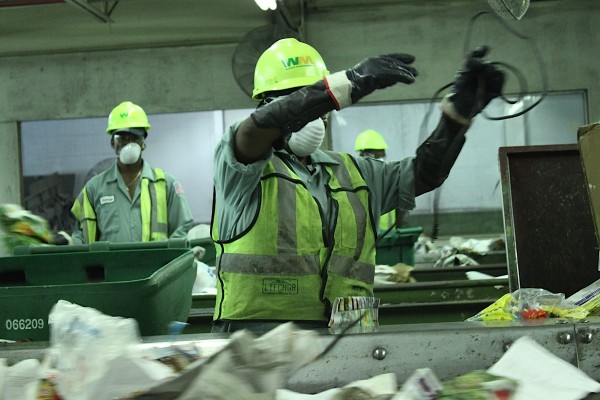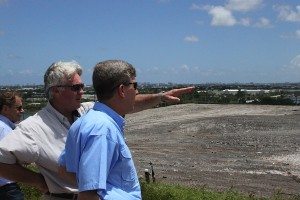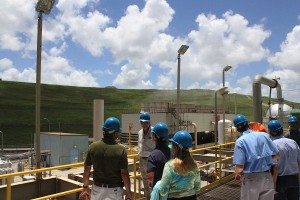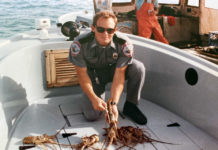
Everything you need to know about garbage and recycling in the Keys
By Jason Koler
An average family of four produces approximately three tons of solid waste each year.
“Big Eddie” Turner burns it.
Even the plastic water bottle that didn’t make it to the recycle container.
Ditto for the newspaper, pizza box, palm frond, soda can, diaper, lobster shell and anything else that ends up in the curbside garbage can.
Turner is one of the crane operators at Waste Management’s energy plant in Pompano Beach where more than 2,000 tons of household waste are incinerated every day – creating enough green energy to power 50,000 South Florida homes.

Out of Sight, Out of Mind
“Back in the 50s, every little municipality across the country had their own little dump,” said Greg Sullivan, Waste Management’s Senior District Manager for the Florida Keys.
Today, nearly all the trash from the Keys ends up at the Pompano Beach facility and places like Mount Trashmore on Stock Island and Boot Key are just nostalgic reminders of an era when garbage was just that – garbage.
“They dumped everything over there,” said 40-year Marathon resident and city councilman Mike Cinque. “But that was long before high-tech trash like cell phones, lithium batteries and laptops.”
Cinque, who worked for the City of Key Colony Beach in the 70s, can remember hauling yard waste and everything else under the sun over to the dump on Boot Key.
Today, waste is big business that has evolved from rudimentary disposal to Waste Management’s primary mission to reduce, reuse and recycle, and two facilities in South Florida operate 24 hours a day, 7 days a week in conjunction with that focus.
Recycling Refuse
The Operations Manager of WM’s recycling center in Pembroke Pines sounds like the stereotypical “garbage man.”
“Five years ago we retrofitted the plant,” said Brooklyn native Kenny Caldararo. “Now we can mix it all together which makes it easier for yous guys – the consumer.”
Caldararo runs the second largest single string recycling plant in the country, and all the empty beer bottles from the Green Parrot, precious Weekly newsprint and Key Largo Fisheries cardboard is sorted at the facility.

Forty-five tons of material is processed every hour by two shifts separating a precious mixture of plastics, papers, glass, cardboard and aluminum through a network of 110 conveyors.
Pitched at various angles and set at different speeds, each commodity filters through a series of ‘star screens” that resemble giant metal gears. The product is either carried to the next stage or falls into the appropriate bin.
“We process, bail and ship the material,” Caldararo said.
Each commodity carries its own value, and grades are issued for degrees of cleanliness.
“If it’s garbage, then it’s garbage,” said Marathon Garbage Service owner Greg Konrath. “Just take that extra minute, and wash the cans out. If you are not going to wash them out, then throw them away.”
Konrath, who started in the family business long before the push for renewable energy, has seen recycling double in just the past two years; but County Administrator Roman Gastesi says the Florida Keys still only recycle 13 percent of their solid waste.
“We are one of the environmental jewels of this country but lack the environmental leadership in this regard,” he said. “We will do better.”
The recent state of the county report issued by Gastesi’s office called for the upgrade of all three transfer stations, the completion of a recycling program for every county owned building, and the implementation of special programs to recognize businesses that promote and practice exceptional recycling measures.
Konrath said one way to increase recycling is to provide bigger bins and that the three county collectors – Marathon Garbage Service, Waste Management and Keys Sanitary – are currently negotiating with the county to upgrade from 18 gallon to 48 gallon bins.
“It’s about education,” he said. “And studies prove that if you have bigger bins, then you will use them at full capacity.”
A ton of aluminum (roughly 60,000 cans) can fetch $1,700 and the amount of income generated from recycling can trickle back to the taxpayers wallet.
“In our contract, there is language that says when the county reaches a certain volume, they start receiving a portion of the profits,” said Sullivan. “That is what angers me when I see guys hauling out refrigerators and stuff…the tax payers are not getting credit for it.”
[pullquote]“One of the new initiatives for us is to find new materials in the waste stream,” Sullivan said. “Our economy and culture are changing.” – Greg Sullivan, Waste Management’s Senior District Manager (Florida Keys) [/pullquote]
Waste to Energy
“In the late 70s and early 80s, waste companies recognized that we were getting overrun with garbage,” said Waste Management’s Government Affairs Manager John Albert. “So we started to build waste-to-energy plants.”
In the early 90s, Waste Management opened a waste-to-energy plant at the foot of the towering Central Disposal landfill in Pompano Beach.
As trucks arrive at the bays like ants marching to a pile of sugar, the household garbage is poured into a holding tank with a capacity for 30,000 tons of garbage – or roughly two-thirds of all the Key West waste produced in a single year.
From his perch above the pit, “Big Eddie” tosses the refuse like a big salad so the fuel keeps the three boilers at a constant temperature.

Those BTUs heat water that is pumped through a series of steel tubes. The steam is captured at 1,000 pounds per square inch, superheated and then sent to a turbine directly coupled to a generator.
The electricity created from burning trash is th
en sent back into the power grid, and the ash by-product is run through a large, rotating magnet to remove any metals, which is sent back to the recycling center. The ash is then used to cover the landfill at the end of each day.
Albert, who joined Waste Management in 1979, has seen many changes, but notes the biggest advent was the waste-to-energy plant.
“We took something that nobody wanted and turned it into something that everyone needs,” he said.
Recreational Refuse
The mountain of garbage at the Central Disposal center in Pompano Beach is so tall that downtown Fort Lauderdale is visible from 15 miles away, but the rate of growth has been cut by 70 percent in the past five years.
In 2005, the landfill was receiving 10,000 tons of garbage a day.
According to Albert, that number has dropped to about 3,000 tons a day due to rising recycling rates and lower construction waste; the conversion of the landfill to a recreational space, however, might have to wait another 15 to 17 years.
The Setter’s Hills golf course in Chicago was once a WM landfill, and according to Albert, “is a really good track.” He anticipates deeding the Pompano landfill over to the municipalities to become a recreational space.
The landfill itself is also being used to create renewable energy. Methane gas from the decomposing materials can be used to generate electricity or sold to industrial customers as an alternative fuel source. A continuous supply of this gas means that landfills can provide a constant energy supply while reducing dependence on fossil fuels like oil.

The average American produces 4.5 pounds of trash every day and companies like Waste Management, Marathon Garbage and Keys Sanitary are constantly seeking ways to reduce, reuse and recycle trash and its impact on the environment.
Long gone are the days when garbage haulers created looming piles of waste like Mount Trashmore on Stock Island. Today’s garbage men are environmental stewards who see treasures in another man’s trash.
For more information on waste and recycling, contact your local provider.
Waste Management
296-8297
www.wm.com
Marathon Garbage Service
743-5165
www.marathongarbageservice.com
Veolia Environmental Services
853-3433
veoliaes.com
Keys Sanitary Service
453-0334






















